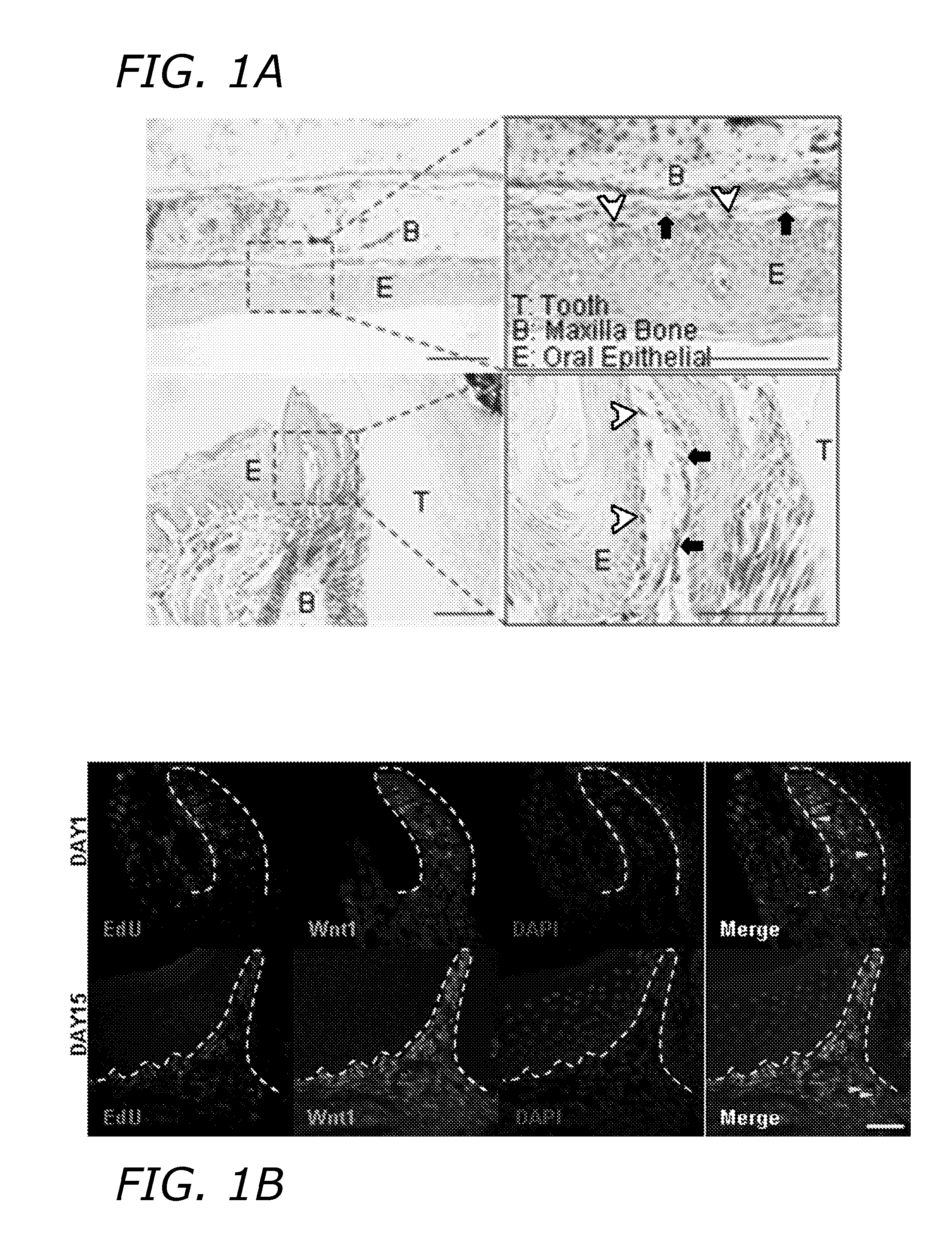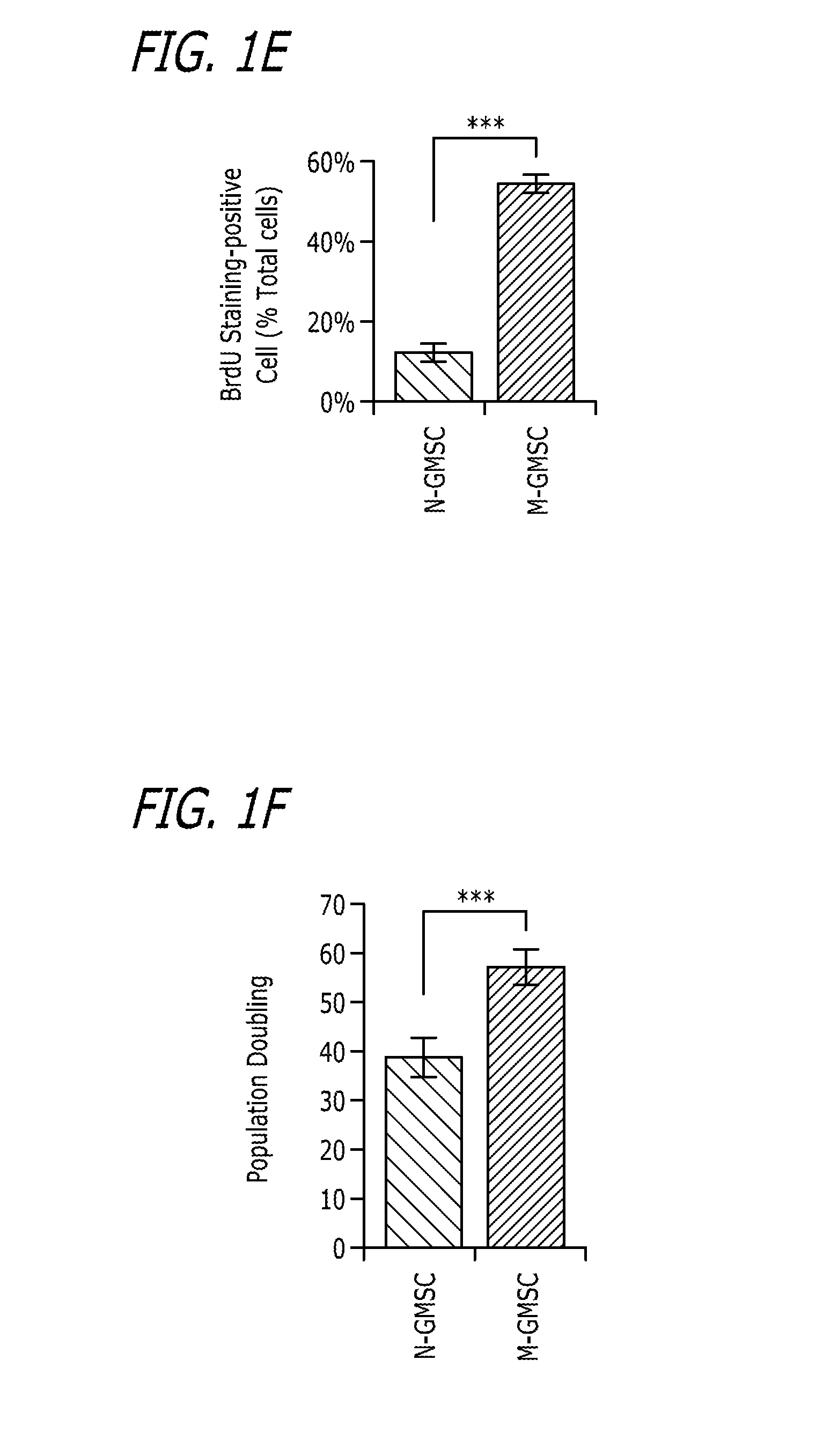Composition of mesenchymal stem cells
a technology of stem cells and mesenchymal cells, applied in the field of mesenchymal stem cell therapy, can solve the problems of limited application range, limited development of stem cells, and significant limitation of the development of their therapeutic applications, and achieve the effects of suppressing peripheral blood lymphocyte proliferation, suppressing immunosuppressive factors, and reducing wrinkles
- Summary
- Abstract
- Description
- Claims
- Application Information
AI Technical Summary
Benefits of technology
Problems solved by technology
Method used
Image
Examples
example 1
Materials and Methods
[0135]Mice.
[0136]Female C57BL / 6J mice and B6.Cg-Gt(ROSA)26Sortm6(CAG-ZsGreen1)Hze / J (ZsGreen) mice were purchased from the Jackson Laboratory (Bar Harbor, Me., USA). Wnt1-Cre transgenic line mice and the R26R conditional reporter (LacZ) mice were gifts from Dr. Yang Chai's laboratory at Herman School of Dentistry of University of Southern California. Mating Wnt1-Cre+ / − mice with R26R+ / + mice generated Wnt1-Cre; R26R mice (double transgenic). Mating Wnt1-Cre+ / − mice with ZsGreen+ / + mice generated Wnt1-Cre; ZsGreen mice (double transgenic). About eight weeks old mice were used at the experiments under the protocols approved by University of Southern California's Institutional Animal Care and Use Committee (IUCAC) (#10941 and 11141).
[0137]Antibodies and Reagents.
[0138]Anti-runt-related transcription factor 2 (RUNX2) and -Osteocalcin (OCN) antibodies were purchased from Millipore (Billerica, Mass., USA). Anti-alkaline phosphatase (ALP), -Nestin, -β-TUBULIN III, -Col...
example 2
Characterization of N-GMSCs and M-GMSCs
[0179]N-GMSCs and M-GMSCs were characterized as follows. X-gal staining showed that gingiva mesenchyme of Wnt1-Cre; R26R (LacZ) mice contained CNCC-derived β-galactosidase-positive cells and mesoderm-derived 83-galactosidase-negative, but Nuclear Fast Red-positive cells, as shown in FIG. 1A. When EdU was injected (i.p.) into Wnt1-Cre; Zsgreen mice for about 7 days and traced for about 2 weeks, majority of the EdU+ cells co-localized with the Zsgreen+ neural crest derived cells. Some EdU+ cells failed to co-localize with neural crest cells (white triangle), as shown in FIG. 1B. When isolating MSCs from the gingiva and culturing at a low density, most adherent single colony clusters were found to be β-galactosidase-positive N-GMSCs with fewer β-galactosidase-negative M-GMSCs clusters, as shown in FIG. 1C. Next, we used Wnt1-Cre; Zsgreen mice, in which CNCC-derived cells continuously express ZsGreen protein and are FITC-positive under flow cytomet...
example 3
Multi-Lineage Differentiation of N-GMSCs and M-GMSCs
[0180]Under the osteogenic culture conditions, N-GMSCs and M-GMSCs showed the same capability to form mineralized nodules, as shown in FIG. 2A, as assessed by Alizarin Red staining, and express the osteogenic markers alkaline phosphatase (ALP), osteocalcin (OCN) and runt-related transcription factor 2 (RUNX2), as determined by Western blot analysis, as shown in FIG. 3A-B. Also, N-GMSCs and M-GMSCs had the same adipogenic differentiation potential, as assessed by Oil red O-positive staining, as shown in FIG. 2B, to show the number of adipocytes and Western blot to show expression of the adipocyte-specific transcripts peroxisome proliferator-activated receptor γ (PPARγ) and lipoprotein lipase (LPL), as shown in FIG. 3C-D. To assess chondrogenic capacity, N-GSMCs and M-GMSCs were cultured in chondrogenic induction media for four weeks. Safranin-O and toluidine blue staining showed that N-GMSCs generated more cartilage matrix than M-GS...
PUM
| Property | Measurement | Unit |
|---|---|---|
| temperature | aaaaa | aaaaa |
| mechanical | aaaaa | aaaaa |
| composition | aaaaa | aaaaa |
Abstract
Description
Claims
Application Information
 Login to View More
Login to View More - R&D
- Intellectual Property
- Life Sciences
- Materials
- Tech Scout
- Unparalleled Data Quality
- Higher Quality Content
- 60% Fewer Hallucinations
Browse by: Latest US Patents, China's latest patents, Technical Efficacy Thesaurus, Application Domain, Technology Topic, Popular Technical Reports.
© 2025 PatSnap. All rights reserved.Legal|Privacy policy|Modern Slavery Act Transparency Statement|Sitemap|About US| Contact US: help@patsnap.com



